Everyone wants to know how to build a functioning outbound team that brings in the right leads. So what do you need to know about building your first outbound team in order to get it right the first time?
Aaron Ross of Predictable Revenue leads this eye-opening discussion with Ryan Donahue, Sales Development Manager of Venminder; Andrew Berger, Director of Sales Development at Square; and Alicia Anderson, Sales Strategy at Captivate.
The panelists delve into how long you can expect it to take to get your team to be productive (it varies greatly!), the mistakes they made that you should avoid, which tools are the best ones for SDRs to use and more.
TRANSCRIPT
Announcer: Ladies and gentlemen, please welcome back to the stage, Aaron Ross.
Aaron Ross: We have a full house. Look at this. We’ve got people sitting in the aisles, jammed in the sides. Thank you. We have a great panel for you today.
I’ll introduce three of my cohorts. I’ll start with Alicia Anderson. Come on up, Alicia.
Aaron: Alicia actually has worked with me before, right now running an SDR team at a company called Captivate. How many people?
Alicia Anderson: There’s about 10 of them.
Aaron: 10 of them, great. Has built multiple teams. We’ve got Ryan. Well, come on up, Ryan. Ryan, I have known you for years. For some reason, I’m totally blanking on your last name at this moment.
Ryan Donohue: That’s Donohue.
Aaron: Donohue. That’s right. Thank you very much. Are you running a team at Venminder right now?
Ryan: Yes.
Aaron: Helped build multiple teams. Excellent. How big is that team right now?
Ryan: Currently, right now we’re at eight reps.
Aaron: Eight? OK. Last but not least, we got Andrew Berger from Square.
[applause]
Aaron: Come on up. Hey, Andrew, thanks for joining us.
Andrew Berger: Absolutely. Thanks for having me.
Aaron: You came like a block or two away?
[laughter]
Andrew: Just a block away.
Aaron: Alicia’s from New York. You’re based in Colorado.
Andrew: Yes, Denver.
Aaron: I’m up from LA. I came yesterday morning. We’re talking about building outbound teams your first time. I know I have my notes here. Here we go. Before we get to that, I want to actually start with a quick, fun fact. SaaStr cash doesn’t really help me here.
[laughter]
Aaron: Maybe, Andrew, I know you said you have a new fun fact, just about yourself, something personal or weird, that’s fine.
Andrew: A couple of things. One, I’m probably the only person in this building, probably San Francisco, that swallowed a toothbrush at 18 months old and still here to live the tale.
[laughter]
Andrew: I gave my mother and my father a heart attack, but we’re here. In a former life, I used to play professional sports. I’m sure a lot of you know that sports translate to sales…
[crosstalk]
Andrew: …I’m here today and here it is.
Aaron: Which sports?
Andrew: I played baseball. I was with the Diamondbacks and the Giants in the Minor Leagues. If you ever want to know what it’s like to be a Minor League baseball player, it’s just like being an SDR. You’re grinding every single day.
[laughter]
Andrew: There is no glory. You’re taking 10 hour bus rides from Augusta, Georgia to Kentucky up to Pennsylvania back down to the middle of the summer. It’s a grind, but the glory is at the top.
Aaron: Mr. Ryan Donohue?
Ryan: Yeah, Donohue.
[laughter]
Ryan: Interesting, fun fact…
Aaron: It doesn’t have to be interesting.
Ryan: …morbid, I guess, but I collect skulls. Not human skulls.
[laughter]
Aaron: Pokémon skulls?
Ryan: Yeah. I just got a gift from my folks in the mail. My mom texts me and said, “Hey, check your front door.” My dad texts me, “Hey, did you check your front door?” I’m like, “What’s going on? All right. I’ll check my front door.”
So I check the front door and it was an Amazon coffee cup that has a skull in the bottom. An actual form of skull and it’s pretty cool.
[laughter]
Ryan: Like I said, kind of morbid.
Aaron: Still like you. Alicia?
Alicia: I’m known spontaneously to break out into my favorite Prince song after any presentation that I give.
Aaron: That’s good.
Alicia: If you’re lucky. [laughs]
Aaron: See you about in 20 minutes.
[laughter]
Aaron: Quick question to start off. If you don’t have a team today or you’re just at the very early stages, how long does it take to get a team built where you have something working? I feel like that’s a huge misunderstanding for time. Alicia, what would you think?
Alicia: To get something as working as an optimized pipeline or just traction?
Aaron: We’ve got some traction. We’ve got something working here.
Alicia: It takes usually much longer than expected because most people bump up against…
Aaron: Is it 30 days?
Alicia: OK.
Aaron: 12 days?
Alicia: It could be two or three months, honestly.
Aaron: Obviously, you’re fast, too.
Ryan: The way I would look at that is, when can you actually start tracking some actual data that you can start to see some trends in? For me, I think you’re looking at four, five, six months before you can really start getting some data that you can use to help you understand where you’re going, where’s the market, what can you expect as far as quotas?
For me, it’s normally four, five, six months. You can bring people in right away and start churning results if you set up a pretty decent process, but to really have it be predictable…
Aaron: To see how it’s working.
Ryan: Right. Exactly.
Aaron: Unless you can see the funnel, you don’t really know what’s happening.
Ryan: Exactly.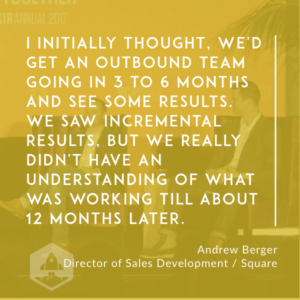
Andrew: That’s a great question. I initially thought, yeah, three to six months, we’re going to see some results. We saw incremental results, but we really didn’t have an understanding of what was working till about 12 months later, to be completely honest.
Aaron: Is that a year?
Andrew: About a year. Aaron says in his book, we use it as the Bible at Square, I give every new hire the book, 9 to 18 months. I was like, “Ow. No way. We’re going to get this thing rocking and rolling much sooner.”
It’s completely true. Still to this day, we’re about 18 or 24 months into it by now, and we’re still now tweaking, we know what to expect, but we want everything to go up and to the right.
We really don’t know what the levers to pull to make things go up into the right til about 9 to 12 months from putting someone in the seat and saying, “Here’s the list. Call.” That doesn’t really work. [laughs] You need to optimize, get with marketing, get with HR, go finance, pay these people.
You ever want to do a payroll and your commission check’s not working, that’s always fun to deal with, too.
Aaron: Great. Ryan, what’s a mistake? You’ve built three or four teams now, something like that, a bunch. What’s a mistake that you’ve made at least once or twice, or you still see people, probably most of the people in this room might be making as they’re getting their first team off the ground?
Ryan: Well, I’ll give the people in the room a break because I don’t know you.
[laughter]
Aaron: Or their last names.
Ryan: There’s a couple of things. Some of the mistakes I personally made is going out and purchasing the wrong tool.
A lot of people out there, I get calls all the time, “Hey, what tools should we use to help our SDRs and make them awesome?” I’m like, “Well, it kind of depends. What’s your process?” There are tools that are built specifically for certain processes.
Really, what the tool’s supposed to help you do is help your reps become more efficient, and then also help you with tracking data. Getting the wrong tool that doesn’t fit your process can be a real setback eventually.
Aaron: Why did you buy the wrong tool? Was it because someone told you to invest, and you just bought it? Was it because you didn’t…? What did you miss, if we’re evaluating, and we’re looking at this?
Ryan: I’ll be honest, I’m a demo junkie. I love sitting through demos of the latest and greatest stuff out there. I dig it.
Aaron: That’s Ryan Donohue, you guys. That’s Ryan Donohue.
[laughter]
Andrew: 200 emails. [makes sound]
Ryan: I didn’t even think about that, man.
[laughter]
Aaron: You’re so screwed. Shouldn’t have given me your last name again.
Ryan: I’m a sales guy at heart, too. I’m an easy sell.
Aaron: Again, Ryan.
[laughter]
Ryan: I didn’t ask the right questions.
Aaron: Like?
Ryan: For instance, is there a limit on how many emails my reps can send per day?
Aaron: Some of the tactical day to day.
Ryan: Just the functionality.
Aaron: How long do you think you should be running a team, let’s say, it’s two weeks, a month, two months, before you feel like you might have a better sense of knowing how to evaluate the right tool, if you haven’t done it before?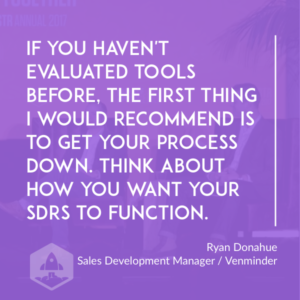
Ryan: So, if you haven’t done it before, the first thing I would recommend is get your process down. How do you want your SDRs to function?
Aaron: Process first, and then before tools.
Ryan: Exactly. I know there’s a lot of talk out there about people, process, tools.
First off, you need to, number one, make sure you have the right person running the team, building out the sales development team, business development team because if you don’t, you’re going to run into a lot of mistakes that are going to be made, that are going to set you back. You’re not going to be tracking the right data that’s going to help you be actionable.
That is the biggest mistake, quite honestly, that I see out there with…
Aaron: Wrong leader of the team.
Ryan: Yeah, you’ve got the wrong person running it. It’s typically the first SDR you hire who really kicked ass. You’re like, “Oh my god, they’re amazing. You should be the manager.” They don’t have a clue what they should be tracking or how to coach somebody.
Aaron: Actually, I’m going to take that, it’s a great point I want to get to, and use that with Alicia here, which is, if you’re starting out and you either don’t have someone who’s a dedicated SDR or you can’t get a dedicated manager or dedicated SDR, you sort of have to work with part people, or part time.
What do you think are some ways to get going when you can’t put as many people or as much focus as you want on it, but you’re ready? Do you run into that much?
Alicia: Definitely. Where I’m working now at Captivate…
Aaron: Not everyone can get a manager up front.
Ryan: Not everyone, no.
Aaron: It helps, but…
Alicia: Generally, you would start with specializing your time. You’re not necessarily going to have a specialized team, but you will be able to…
Aaron: Have one person.
Alicia: Have one person divvy up their time and designate call blocks and email blocks where they can devote their time specifically to prospecting because that’s when you’re going to get the best results when you can actually focus because it’s really difficult to switch gears to go from, “I’m a hunter to now closing to account management.”
Aaron: It could the founder who set aside a day, like Tuesdays, or something.
Alicia: It could be, exactly. It could be whether it’s hours within the day, or it could be entire days where you’re just focused on one particular piece of the funnel. That’s when you’ll get the best results.
Ryan: Let me add one more thing to that, too. What I said about hiring the right manager, that’s really hard to do. There are not a lot of people who are…
Aaron: Still are new-ish…
Ryan: …proficient in this. It’s not an easy task.
Aaron: Besides you, that is.
[laughter]
Ryan: Once again, Ryan…No, I’m just kidding.
Aaron: It’s tough. The current form of that role hasn’t been around for that long. It’s still relatively…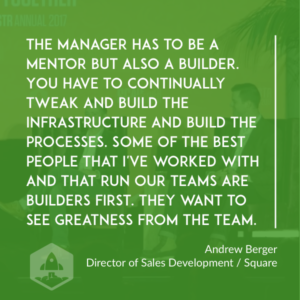
Andrew: To jump in there, it’s a great point because the manager, the way that I see it, also has to be a builder. You have to continually tweak and build the infrastructure and build the processes. Some of the best people that I’ve worked with and that run our teams are builders first. They want to aspire to see greatness from the team and from our production.
Yes, they have to mentor and be in the trenches, but they also understand the metrics. They understand the processes. They understand how activity tracking works in Salesforce to take a step back and see everything from a bird’s eye view but also can dig in and tweak when necessary. You’re the builder versus manager a lot, where I’ve seen success or I like to jump in, is I like to build things, too.
The people that are successful at Square, specifically in these types of roles, in these manager roles, are people that want to build as well. They tweak continually to push and pull what role yield the most success, and not just be this high level like, “OK, go make 30 calls. Go make 200 emails,” but they want to dig in and build as well.
Aaron: Andrew, now it’s been, you’ve been at this, a couple of years. Everyone wants to know about the fucking email template.
[laughter]
Aaron: “What do I write in my email?” In the scheme of things, would you rank, the email templates that they write, the specific ones, and separate that from the ability to write, so certain templates, was that in the top 10 percent most important things? 1 out of 10, how would you rate its importance because people obsess about them?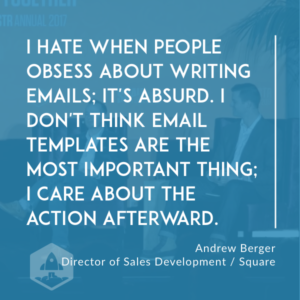
Andrew: I hate when people obsess about writing emails. I just want to them to throw shit at the wall and see what sticks and read off of that. Sometimes, I see people spending literally hours trying to tweak their language, misspell words on purpose for it to prospect thinks that they’re actually human. You’re not spelling 100 percent purposely.
Aaron: Not a template. [laughs]
Andrew: It’s absurd. I don’t think email templates are the most important thing. I care about the action after the email, whether that person responded to you, great, or did they open the email? Every tool out here can you tell whether they opened it or not.
Did they call you? What did you do after that email? Did you follow up one day, four days, five days, seven days? I care about the action afterwards. That’s what I want to see.
The email templates, yes, it’s important, but I’m sure everyone here gets 20, 40, 50 emails a day, selling the next best thing. There is basic templates to fit in a cadence, a sequence, a template, or whatever happens afterwards, but I care about the next step afterwards, what action is yielded from that. Going back to your question about the template, five.
Aaron: 5 out of 10.
Andrew: I don’t care. I tell my friends who are running their own companies that their founders are digging in because they don’t have sales. They have 10 people, and they’re just trying to get their feet off the ground. Just go. Stop spending time looking at the computer, trying to tweak the best language.
Throw stuff at the wall, see what sticks. OK, you get 10 percent? OK, what did you do for those 10 emails out of 100 that worked? OK, now tweak them a little bit and do it again and again and again.
Aaron: Great, OK. We got about 10 minutes. A really important topic now, obviously as I mentioned before is, a lot of people, again, doing their first teams, don’t realize the potential differences between different types of companies, in different verticals, different industries you target.
Now, you have been at companies… Even at Captivate, you guys have two lines of business, different verticals. What has it been like, and how similar or different can be the different types of verticals that you’re targeting?
Alicia: It’s interesting because you can be within one organization, and it can be like night and day from one side of the business to the other. Even within the ad sales side of our business, we’re going after multiple verticals, and each one of those is completely different.
The only thing that I would say would be consistent is our value proposition on that particular side of the business, but how we’re positioning our conversation, and who we’re going after, they may be heads of marketing, but our conversation is completely different.
It takes a lot of time to figure out all those nuances when you go into a new vertical. It takes more time than what usually people expect and anticipate. You just have to build that into your process long term.
Aaron: We actually call it nailing a niche, which is the first part of the From Impossible book. Again, that section, if you don’t know, is from the From Impossible to Inevitable. It’s the book I did with Jason Lemkin.
The whole first section, “Nailing a niche,” came because for years, when people struggled with outbound it’s because they hadn’t nailed the niche. That’s number one. What’s a niche that you’ve nailed with Captivate?
I know you’re working on multiple niches. How long did it take to nail that first niche? How long are you expecting to take to nail the second niche? Because you’ve nailed financial services or…
Alicia: Right. We’ve gone after finance. We actually had some issues because of that exact conversation in nailing a niche. We actually learned a lot in what we didn’t know. We only had three months in terms of how we’re going to go after that vertical and actually conquer it. It’s not enough time.
We’re actually planning to circle back to it, but we’ve launched into a couple new verticals, which are travel and automotive, focusing on our niche there. We’re seeing tremendous success. Within one month, we’ve achieved the same conversion rates that we were achieving after three months in finance.
Aaron: Even though you have a working team, sometimes you have to almost like…not starting from scratch, but it doesn’t mean you’d have automatic success in the next market as well.
Alicia: Absolutely.
Aaron: Sometimes you will, sometimes you won’t.
Alicia: It varies tremendously.
Aaron: Just one point, what about, for example, calling versus financial services and versus…I know you mentioned before, when we were getting ready. One vertical, people don’t pick up the phone at all, but in another one, people pick it up like crazy.
Alicia: Exactly.
Aaron: Which were they?
Alicia: In finance, we didn’t get basically anybody on the phone. We were generally getting voice mails, or we’re just getting automated systems, where you actually couldn’t even get a live human on the phone.
In terms of travel, that vertical they’re willing and want you to speak with them. They pick up the phone all the time. Our conversion rates are incredible. We’re getting referrals left and right. It’s completely different. Obviously, you tweak the tools that you’re using in outreach based on those variables within each vertical.
Aaron: Part of that lesson is don’t stay behind your computer just emailing all the time. Also, pick up the phone and realize what works in one target market might vary to the next.
Actually, how do you guys look at the phone/when you look at email versus phone versus other like social, what are the priorities? Are they all equal? Is one dominant?
Andrew: We talked about this. You go ahead. [laughs]
Ryan: Look, I think the phone is probably the number one tool an SDR has in my opinion.
Aaron: Phone is number one?
Ryan: Phone is number one.
Aaron: Good to know.
Ryan: That is the number one.
Aaron: I wouldn’t disagree.
Ryan: I appreciate that. [laughs] Email is important. We use email as a tactic to make that cold call, not so much a cold call, so that they’ve seen an email from the SDR, and they see the name.
They might not have paid attention. They might not have even opened the email, and probably 70 percent of the time, they don’t, but when you call and that name triggers something within the prospect’s mind like, “Oh wait, that sounds familiar.”
To me, calling is vastly important. My SDRs book 75 percent of their meeting through the phone, versus email.
Aaron: Are those generally cold calls, or they’re calling direct? Is it follow up calls, if they have emailing because you can have multiple types of calls? There’s mapping calls.
Ryan: Right, so it’s typically within the workflow cadence, whatever you want to call it. It’s the series of touches that you make at a prospect. Our first touch is always an email. Second touch is a phone call, third touch is another phone call, but we don’t leave a voicemail, so they called it a ghost dial.
It depends, we’ve done a lot of data gathering, data mining on when is the best touch that we actually get the most appointments booked. Really what I try…
[crosstalk]
Aaron: …which is?
Ryan: Which is step one. I’m sorry, step two, so the first phone call, ironically. What I really try to look at is, so when my reps, we track when they connect with somebody. When they connect with the prospect that we’re trying to speak with, I want to know how many of those converted to a meeting.
You could have a rep who sets up 30 meetings, and you’re like, “Man, that rep’s a rock star. Right on.” That rep also talked to 100 people, but you got another rep who set up 25 meetings, and talked to 35 people. I want to know what that rep’s doing, and I want to emulate that.
I saw an article on LinkedIn a few weeks ago and they call it, I think it was Steve Richards, they call it your batting average. What’s your rep’s batting average? That is one of the most important metrics that I try to track and help coach my reps on, so the phone is vastly important.
Andrew: I couldn’t agree more. I think understanding what process is, you first have to understand how does your business make money? What are the economics? What are the unit economics?
Our business is probably different than a lot of people’s businesses out there, where we have to close a ton of velocity, and we’re selling to, everyone in this room would say SMB, but for us, they’re like large businesses, local businesses that actually process money, that use point of sale technologies.
With that, who we target, they are usually by a phone, whether it’s any vertical, or any segment, our board of directors in our board meeting, we’d go out to the market and we’d say, “There’s 48 million businesses in the United States that could potentially use Square.”
It’s like, “How do we [laughs] find your niche, and then focus on there?” Per vertical and then per segment of those verticals, they have different propensities to what they respond to.
I always instruct our team, our managers instruct their teams, have an email first and then use that as leverage for the phone call. I’m always about what’s the action after the email.
You reference that, whether it’s saying an update, whether it’s…of course, we hate the check ins and follow ups, and, “Hey, I’m just here to check in. You got my email.” You use it as leverage because maybe they’ve read your email, they’ve seen your name, and then you say your name.
You explain why you’re calling. I couldn’t agree more, there’s nothing that emulates the human touch. We love chats, and chat bots, and this, and that. Everything’s trying to be faster, but at the end of the day, I only see success by the people that are not afraid to pick up the phone and not afraid of rejection.
Aaron: Usually, it doubles your results when you take the phone seriously.
Andrew: Yes.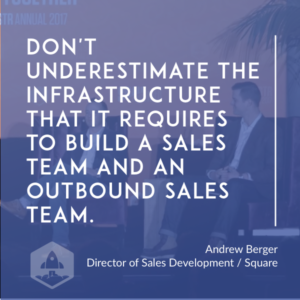
Aaron: We’re almost out of time, so quick question first. By the way, I know there’s a lot of people here. Maybe, if you have questions, you want to mob them, maybe go hang out at the…I have another panel after this, but if you hang out at the Predictable Revenue booth in the hallway, it might be easier for people to manage.
In terms of a last tip to leave people with, let’s start at this end.
Andrew: The last tip, don’t underestimate the infrastructure that it requires to build a sales team, an outbound sales team, especially from my experience of being a product driven organization, high organic growth, building sales on top of that, and building an outbound sales team, it’s vastly different.
Infrastructure, technology, HR, finance, you got to know what you’re getting into. You have to work cross functionally or you can’t be a maverick on the sales side.
Aaron: I think earlier you said, it took three quarters just to get your tools and actions and such…
Andrew: We couldn’t even put a comp plan in for six months for internal reasons, and you have to make your relationships, and leverage people internally to understand what your shared goal is.
Aaron: I will emphasize. I usually tell teams not to put a comp plan in too early, wait a few months till they have some data before. Otherwise, you’re only going to fail because either it’ll be too aggressive and they’ll miss it and be upset, or it’ll be too easy, and they blow it away. They get upset because they didn’t chop it.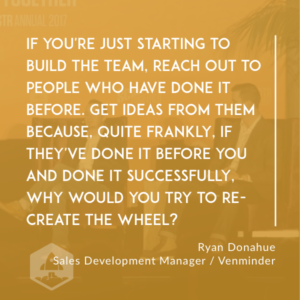
Andrew: That’s such a good point. There’re so many people that put really high goals, and you get people discouraged, and then you get churned, or you put goals down here when you’re first getting started and you’re getting overexcited, and then you come back and then they’re all angry at you because, guess what, your goals here, but now it’s here.
Aaron: Yeah, quotas up, quota.
Ryan: Building an SDR team, let alone, is hard, but imagine for the SDR. If you don’t have a process built out for them that, number one, helps them be efficient, and number two, helps them be successful.
If you’ve never built a team…When I first got into this, InsideSales.com was a big deal back then and they were an inbound engine, and so I reached out to Ken Krogue on LinkedIn, never met the guy, to say, “Hey, I’m just building out this business development, sales development team. I know you guys are a mad house over there. If you could spare a couple hours, you tell me when and where and I’ll be there. I’d love to pick your brain.”
He actually got back to me and said, “Come out to Utah. Spend the day with us.” I went out to Utah and spent the day at InsideSales.com, and they have a massive SDR team, inbound team, sales team, and it was awesome. It was great, and I learned a ton.
If you’re just building the team, reach out to people out there who have done this before. Get ideas from them because, quite frankly, if they’ve done it before you and done it successfully, why recreate the wheel?
Aaron: Yeah, a lot would be helpful. Alicia?
Alicia: My recommendation would be to create a solid process for hiring those builders. I think the biggest mistakes you can make early on is hiring growers instead of builders.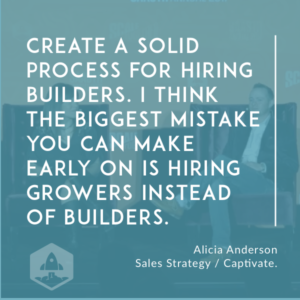
I know that’s very expensive, and it ends up there’s a huge impact on the team, ultimately, and you want to avoid that long term, so if you can get the right people, right out of the gate, who are actually are hunters, and are going to build your program, and bring in those new leads, then that’s the most important thing.
Aaron: Last thing…Frank, can you switch the slide? I haven’t put it up yet. I forgot to put it up before they ran out of time. On my Twitter, we have a couple of tools. If you were here the last session, we have a couple things from Ralph Barsi and Mark Roberge. I just put up here.
I will put up, too, in either five minutes, or like an hour. It’s called, “The Deep Dive 25 Exercise.” It’s my favorite project based learning exercise for new SDRs. It’s the basis of our Predictable University group training. I’ll put it up here soon, again, like after this, or an hour. It’s @motoceo, on Twitter.
I want to thank you all for coming up and doing the panel. It was fun.
Alicia: Thank you.
Ryan: Thank you.
Aaron: If you’re sticking around…Alicia…

